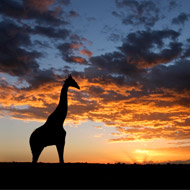Calls for ‘urgent review’ of wild giraffe management

Lead author Zoe Muller warned that the continual loss of juveniles could lead to “an unrecoverable situation".
Scientists are calling for an urgent review of how giraffes are managed in the wild, as new research shows living alongside lions can significantly reduce the number of giraffe calves.
A study published in PLOS ONE suggests that if lions and giraffes are kept in the same conservation area, the number of calves may be reduced by up to 82 per cent.
Researchers from the University of Bristol studied two adjacent sites - one with no lions and one with a high density of lions. It found that the presence of lions has a significant impact on the demography of giraffe populations. In areas with no lions, the giraffe population contained 34 per cent juveniles, but when lions were present the population contained only six per cent juveniles.
There is anecdotal evidence to suggest that lions target giraffe calves in the wild, but previous research has not investigated whether this preference has an impact on the population as a whole.
Lead author Zoe Muller, a Bristol PhD student, warned that the continual loss of juveniles could lead to “an unrecoverable situation where the population crashes”. Population growth and sustainability are reliant on a sufficient number of calves surviving to sexual maturity.
“This research has significant practical implications,” Muller said. “Giraffes are a threatened species, suffering ongoing decline in the wild, and this research highlights how managing giraffes alongside lions inside a conservation area (a common practice in Africa) has detrimental effects for giraffe populations…
"This research highlights the need for an urgent reassessment of how populations of giraffes are managed in the wild, given their Vulnerable Red List status and severe and ongoing decline."
Giraffe populations have fallen by 40 per cent in the past three decades and it is thought there are now less that 98,000 left in the wild. Conservation review is ongoing as it is thought that some subspecies may be at even higher risk of extinction than is currently recognised.
Further research is now needed to determine whether these findings also apply to other parts of Africa.



 BSAVA is to partner with BVA Live (11-12 June 2026) to champion clinical research.
BSAVA is to partner with BVA Live (11-12 June 2026) to champion clinical research.